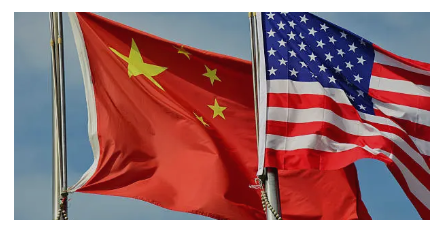Donald Trump’s controversial decision-making started again as soon as he took office. His geostrategic decisions specifically have had diverse but converging reactions: irritation and laughing. His continuous strategy of flooding the public with disinformation in order to distract and block the view of the truth is stronger than ever. With this in mind, Trump’s recent declarations are only understandable at second glance. Indeed, the only connection between all ‘annexion fantasies’ of the United States (U.S) president is, unsurprisingly, China. In addition, we notice a clear paradox in Trump’s foreign policy of claiming isolationism while acting the expansionist way is even more relevant now with his recent claims regarding Gaza.
Gaza
U.S. President D.Trump said the U.S. would “take over Gaza”, and although his plan is not very detailed yet, he wants the resettlement of the whole Palestinian Gaza population to neighbouring countries, and “own it” to make it the “Riviera of the Middle East”. Under which authority would he take over the land and “own it long term” land? He has no answers. These outrageous claims combined with his decision to freeze USAID (United States Agency for International Development) clearly show the path the U.S. want to take in their foreign policy.
The Panama Canal
The canal is central to U.S security interests, and is believed by the U.S president to be operated by China. Looking at the facts, the Canal is operationally managed by Panama. However, China has helped to expand it, build bridges and ensure the energy supply. The Chinese also operate the most important local ports, including the Hutchison Whampoa Group, owned by Li Kashing (Hong Kong), the largest port investor in the world. Thus, although it is not to the extent claimed by Donald Trump, China does have influence in the area.
Canada
The strategic significance of Canada, positioned as the middle ground between Alaska and Greenland, is quite clear. Although Trump claims reasons for tax-cutting and military protection, the main reason behind is about standing up to Russia and China. With global warming, the ice is melting revealing a better access to mineral resources and significantly shorter shipping routes. In 2024, Russian and Chinese coast guard ships were noticed patrolling the ocean together, and both nation’s strategic bombers flew over the Chukchi Sea and the Bering Strait. Following these events, the reason behind Trump’s annexion fantasies is clearer than ever.
BRICS
With the Ukraine war, the U.S have achieved to create a bigger split between Europe and Russia. Both powers will not be converging in the foreseeable future and, as such, won’t become a “Third Player” between China and the U.S. What they did not achieve however, is to bring Putin and Russia “to their knees”. This was successfully prevented by China and the BRICS. The U.S administration has greatly underestimated that the greater the pressure from the West, the more united the BRICS will be. Thus, BRICS, with China as the leader, now represent the biggest challenge facing the U.S as an international group.
Trump’s most likely focus
Donald Trump’s first goal should be peace, a quick establishment would show his power. He has claimed regarding the war in Ukraine that he will create peace there “before 6 months”. The Ukrainians strategic idea of joining the EU and NATO is still out of the question. His goal here is to show how he is the only one able to bring peace. He stands in opposition to the Chinese Head of State Xi Jinping, Chancellor Olaf Scholz and President Emmanuel Macron and wants to present himself as the “sheriff of the West”. Taking this position would also mean for Trump to use China as his deputy-sheriff, where they would take on more international responsibility, and also -perhaps more importantly- keep Russia in check. The paradox lies in Trump’s desire to adopt this position, which contrasts with his previous isolationist claims.
Trump’s vision for peace in Ukraine is one where there’s enough stability to stop the fighting and focus on rebuilding, but not so much stability that it prevents him from pressuring the EU to take on more responsibility for its own defense. Trump is attacking the EU’s greatest weakness, their shortage of money. Especially due to the government’s failures regarding budgets in France, Germany and Austria. Pushing Europe to take more care of their own security means lower costs for the US as well as more business for the US arms industry. An additional benefit to that is that, seeing that if the tariffs threat don’t work on Europe, the defense numbers will.
However, the central element of Trump’s geostrategy reflects a key aspect of past approaches: the attempt to create a division between Russia and China, and use China against Russia. The challenge in this strategy lies in the necessity for Trump to partially normalize relations with Putin, potentially bypassing the interests of the EU. This double vision of Putin being evil for Europe and useful for the US, is a strong reminiscence of the time when Richard Nixon was president of the US. Then security advisor Henry Kissinger saw Mao as useful and proposed the “Ally with China against Moscow” strategy.
Mao had fallen out with Moscow, there was border conflict. Kissinger arrived in Beijing in 1971 bearing gifts, with the intention to make it clear the US were looking for a pact, not a political whim. At the head of the US liaison office in Beijing was George W. Bush, US president 15 years later. How does this connect to 2025? After Trump’s victory in 2016, Kissinger engaged in multiple discussions with him, attempting to persuade him that aligning with Moscow against China would serve the interests of the U.S. However, the unexpected conflict in Ukraine erupted just one year after Biden assumed office. Following the West-imposed sanctions, Putin found refuge with the BRICS, which are very against the sanctions and are supported by the majority of the world. Nevertheless, the close relation between China and Russia, supported by the Global South, has a weakness. It is not a partnership of equals. Putin is dragged by the unexpected length of the war and the severity of the West’s reaction and has to become exponentially dependent on China and the BRICS. Thus, the “Reverse Kissinger” strategy seems more appropriate than ever. The only thing President Trump now has to do is to strengthen the gravitational forces that already exist. Normalizing his relations with Putin by lifting some sanctions is enough. Not only would this be beneficial for him, it would weaken the China-Russia ties.
Thus, Trump’s foreign policy, marked by unpredictability and strategic maneuvering, appears as a deliberate attempt to revive past geopolitical tactics while focusing intently on countering China’s rise. His approach still sparks mixed reactions, but the central aim is unmistakable: reshaping global power structures to favor U.S. interests, often at the cost of established alliances and norms. Whether these strategies will result in lasting success or simply escalate international tensions is unclear yet, but the echoes of past policies remain noticeable.


Comments are closed